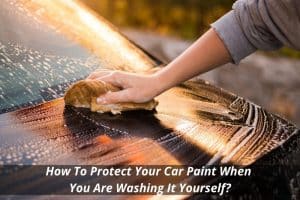How to Protect your Car Paint When you are Washing it Yourself?
In this blog, we were going to answer How To Protect Your Car Paint When You Are Washing It Yourself? and What should you do?
If you wash your car at home, you might want to consider using a pressure washer instead of soap and water. The spray paint from these machines contains strong jets of water or steam that can easily damage the finish of your vehicle. When deciding whether to use soap or detergent, choose a mild cleanser that won’t strip away too much of the original colour tone.
When you wash your car, you’ll want to follow some basic rules. For example, don’t clean under the hood or near the wheels because they get really dirty and slippery. Also, never put a bucket underneath the car since it will soak through the concrete floor and cause puddles on the driveway.
Finally, be sure to avoid cleaning up spills with paper towels or rags because this could scratch the paint surface. To keep your car’s paint looking new, try one of our popular car care products below.
1: Prorol Car Wash – This all-inclusive carwash product will help prevent scratches and other imperfections while keeping your car’s paint in top condition. It can also be used for exterior and interior surfaces.
2: Tuff Wax – A tough wax designed specifically for protecting your car’s paint surface. If you have any questions about how to apply it correctly, please call us.
3: Diamond Protect Plus – This two-part product is suitable for both vehicles and motorcycles. Our customer service loves it! Use it as an all-purpose cleaner and protectant to maintain the beauty of their vehicle’s paintwork.
4: Ceramic Pro Paint Protection Coating – An economical way to add extra protection to your car’s existing paintwork. It creates a hard, non-stick film and provides excellent chemical resistance.
5: Window Film Kit – These clear films cover the windows of your car and are ideal for blocking out sunlight and reducing glare. They can also be used as protective window wraps.
Should you wash with soap or without?
You should always wash your hands before eating or preparing food for others, even if no germs were on them. Some people use hand sanitisers instead of washing their hands, but they are not completely effective against all bacteria.
Handwashing removes dirt and germs that can make us sick. Washing with soap helps remove excess oils and grime from the skin. Soap and water work well together and are equally good ways to wash your hands.
However, using soap may be easier than washing your hands with plain water. You can buy soaps specially formulated for washing your car, which contain special ingredients that can help remove grease and dirt from your paintwork.
It’s important to remember to disinfect your tools after each use and to sterilize or boil your containers of soap and shampoo. Always keep hand sanitisers readily available in case of emergency.
Does car wax work against rust?
Some types of wax do appear to hold moisture in the pores of the metal, which may slow down corrosion. Waxes don’t stop rust, though, and if you have a rusty area, there is little point in applying wax over it. But if you’re dealing with a small problem such as a dent, you might find that adding even a tiny bit of polish does wonders for making repair jobs look almost like new again.
Waxes come in many forms. There are polishes (often called “polish,” “wax” or “cleaning agents”), which are sprayed onto bare metal surfaces; enamels, usually applied by brush; and lacquers, sprayed directly onto the final painted surface.
No matter what kind of treatment you use, car wax won’t stop rust stains. Rust stains cannot be removed by simply polishing the affected area. You need to take action to stop further damage. There are several techniques for removing rust stains and we can recommend the best method for you.
However, there are many factors that affect the effectiveness of each technique, such as where on the body the stain is located. We strongly suggest contacting a professional who has experience dealing with rust stains, especially if the problem is serious.
What is the difference between a waxed car and a car wash with soap only?
Waxing involves applying a layer of wax to the car’s surface. The wax forms a barrier over the entire painted surface. As long as the wax remains intact, it acts like a shield to keep oil products and other substances out of the paint correction. When you drive, the wax keeps moisture away from the paint.
How often should you clean your windshield wiper blades?
This depends on how dirty they get during use. If they become soiled while driving that you can see dirt on the blade itself, then you’ll want to change them more frequently. Otherwise, you can expect to replace them every three months or so.
The cleaning process is simple: Just wipe off any debris that collects on the blades’ rubber tips. Then spray some cleaner on a soft cloth, rub the tip back and forth across the blade, and rinse thoroughly.
If you’re concerned about getting too much dirt into your eyes, you can also wash the blades under running water. Be sure to wear safety goggles and gloves whenever you clean the blades.
How to prevent scratches on your car windows?
There are ways to avoid scratching your vehicle’s window glass:
1) Avoid touching the glass with anything rough. This includes fingernails, jewellery, hairbrushes, and keys – all items that could scratch the glass.
2) Use high-quality plastic guards to cover areas where you need to touch the glass. These guards can reduce the chances of damaging the glass. They are attached using suction cups, tape or magnets, and can easily be taken off for cleaning.
3) Clean your windshield regularly. Clean it at least once a week, preferably twice, and never leave it uncleaned for longer than 24 hours. A good way to clean the windshield is to start at the top left corner and work your way down, wiping the glass with a microfiber cloth soaked in warm water.
4) Wipe the outside of the windshield frequently – even after it is dry. It is very important to do this because it helps remove smudges and fingerprints.
5) Keep your wipers trimmed so they don’t clog up.
6) Replace your windshield washer fluid every six months.
7) Don’t forget to check your rearview mirror before backing out! Make sure no one is behind you.
8) Never use rubbing alcohol to clean your windshield. Alcohol will break the protective film inside your windshield, causing it to crack.
9) Never use a power washer to clean your windshield – unless you have an anti-scratch product installed. Power washers can damage the glass by blasting it with intense heat and pressure.
10) Do not store your car in direct sunlight or use an air conditioner (or heater) near your car windows. Too much heat can cause them to fog up.
What are the benefits of Car paint?
The benefits of car paints can be divided into three main areas: functional, performance, and aesthetic. They perform well in all aspects of the application while providing an attractive appearance for your vehicle’s exterior.
Functionally, they provide UV protection from the sun, which protects your interior from fading. The chemical composition of modern paints allows them to resist moisture, preventing them from cracking, peeling, or flaking. Paints also help to improve the overall grip of the surface, making them easier to control on slippery surfaces like wet roads or ice.
Performance-wise, car paint protection offers better fuel economy due to its low weight and aerodynamic shape. In addition, modern paints are designed to be durable, long-lasting, and able to withstand extreme conditions without cracking, chipping, or peeling.
Aesthetically, car paints can add value to your vehicle through improved resale ability. Many manufacturers offer warranties on new cars but these are often voided if the manufacturer’s paint starts to chip, peel, or fade. With car paints, however, you can rest assured knowing that a warranty will remain valid regardless of how well your car looks. Plus, they’re easy to maintain and repair – simply apply a fresh layer whenever you notice any signs of wear and tear.
Car Spray Paint Types and Application Methods
There are two major categories of automotive coatings: metallic and nonmetallic. Metallic paints include aluminium, bronze, chrome, gold, silver, red, white, yellow, green, blue, black, pink, purple, and other colours. Nonmetallic paints are used primarily for clear coats, such as those found on wood trim, fibreglass, vinyl, plastics, and leather.
Metallic paints are the most popular option for both new and older vehicles. Older vehicles tend to require more maintenance since they’ve been around for a longer period of time and have seen more exposure to weather elements.
However, for newer vehicles, there is still a benefit to applying a metallic finish. A metallic finish offers increased visibility and has a unique look. It’s especially useful if you want to show off a personal design element, such as custom wheels or graphics.
Nonmetallic paints are usually applied after metallic paints but before weatherproof coatings. This type of paint provides additional paint protection products against environmental factors, including water, road particles, and pollutants. It works best on plastic materials, such as bumpers, door panels, and wheel covers.
Regardless of whether you decide to use metallic or nonmetallic paints, make sure that you choose the right one for your specific project. Some brands may cost less than others, but they won’t last as long and may not work as effectively. Before purchasing any product, always check the label to ensure that it contains what you need. If you try to use a different brand, you may end up with something inferior and even damage your vehicle.



